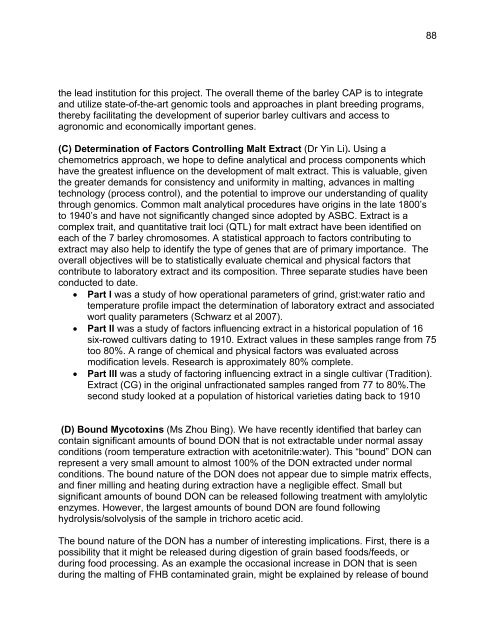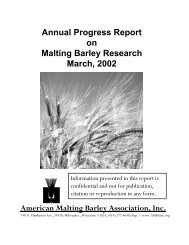Annual Progress Report on Malting Barley Research March, 2007
Annual Progress Report on Malting Barley Research March, 2007
Annual Progress Report on Malting Barley Research March, 2007
You also want an ePaper? Increase the reach of your titles
YUMPU automatically turns print PDFs into web optimized ePapers that Google loves.
the lead instituti<strong>on</strong> for this project. The overall theme of the barley CAP is to integrate<br />
and utilize state-of-the-art genomic tools and approaches in plant breeding programs,<br />
thereby facilitating the development of superior barley cultivars and access to<br />
agr<strong>on</strong>omic and ec<strong>on</strong>omically important genes.<br />
(C) Determinati<strong>on</strong> of Factors C<strong>on</strong>trolling Malt Extract (Dr Yin Li). Using a<br />
chemometrics approach, we hope to define analytical and process comp<strong>on</strong>ents which<br />
have the greatest influence <strong>on</strong> the development of malt extract. This is valuable, given<br />
the greater demands for c<strong>on</strong>sistency and uniformity in malting, advances in malting<br />
technology (process c<strong>on</strong>trol), and the potential to improve our understanding of quality<br />
through genomics. Comm<strong>on</strong> malt analytical procedures have origins in the late 1800’s<br />
to 1940’s and have not significantly changed since adopted by ASBC. Extract is a<br />
complex trait, and quantitative trait loci (QTL) for malt extract have been identified <strong>on</strong><br />
each of the 7 barley chromosomes. A statistical approach to factors c<strong>on</strong>tributing to<br />
extract may also help to identify the type of genes that are of primary importance. The<br />
overall objectives will be to statistically evaluate chemical and physical factors that<br />
c<strong>on</strong>tribute to laboratory extract and its compositi<strong>on</strong>. Three separate studies have been<br />
c<strong>on</strong>ducted to date.<br />
• Part I was a study of how operati<strong>on</strong>al parameters of grind, grist:water ratio and<br />
temperature profile impact the determinati<strong>on</strong> of laboratory extract and associated<br />
wort quality parameters (Schwarz et al <strong>2007</strong>).<br />
• Part II was a study of factors influencing extract in a historical populati<strong>on</strong> of 16<br />
six-rowed cultivars dating to 1910. Extract values in these samples range from 75<br />
too 80%. A range of chemical and physical factors was evaluated across<br />
modificati<strong>on</strong> levels. <strong>Research</strong> is approximately 80% complete.<br />
• Part III was a study of factoring influencing extract in a single cultivar (Traditi<strong>on</strong>).<br />
Extract (CG) in the original unfracti<strong>on</strong>ated samples ranged from 77 to 80%.The<br />
sec<strong>on</strong>d study looked at a populati<strong>on</strong> of historical varieties dating back to 1910<br />
(D) Bound Mycotoxins (Ms Zhou Bing). We have recently identified that barley can<br />
c<strong>on</strong>tain significant amounts of bound DON that is not extractable under normal assay<br />
c<strong>on</strong>diti<strong>on</strong>s (room temperature extracti<strong>on</strong> with acet<strong>on</strong>itrile:water). This “bound” DON can<br />
represent a very small amount to almost 100% of the DON extracted under normal<br />
c<strong>on</strong>diti<strong>on</strong>s. The bound nature of the DON does not appear due to simple matrix effects,<br />
and finer milling and heating during extracti<strong>on</strong> have a negligible effect. Small but<br />
significant amounts of bound DON can be released following treatment with amylolytic<br />
enzymes. However, the largest amounts of bound DON are found following<br />
hydrolysis/solvolysis of the sample in trichoro acetic acid.<br />
The bound nature of the DON has a number of interesting implicati<strong>on</strong>s. First, there is a<br />
possibility that it might be released during digesti<strong>on</strong> of grain based foods/feeds, or<br />
during food processing. As an example the occasi<strong>on</strong>al increase in DON that is seen<br />
during the malting of FHB c<strong>on</strong>taminated grain, might be explained by release of bound<br />
88
















